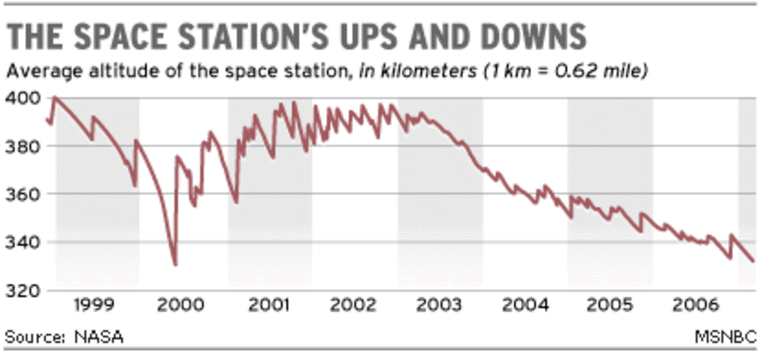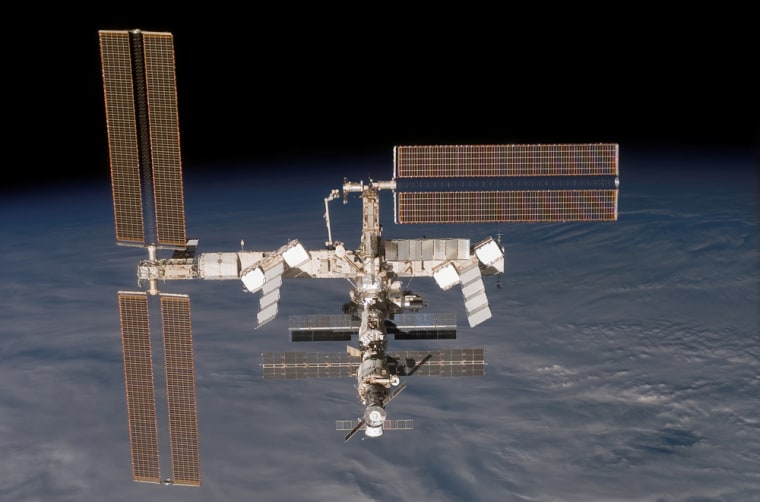The international space station has been literally falling out of the sky, according to NASA tracking data obtained by MSNBC.com. Under the inexorable decay of air drag, its orbital path around Earth has slipped down to 207 miles (332 kilometers), the lowest average altitude in the nine-year life of the project.
A small rocket engine on a docked cargo ship is being fired this week to boost the orbit by a small amount. But since the orbit is continually dropping at about 300 feet (90 meters) per day, the boost will be eaten up by the effects of air drag within several weeks.
A graph released by NASA shows that the gradual decline began in earnest after the loss of shuttle Columbia in early 2003. Prior to that disaster, the altitude had been maintained at a fairly high level, thanks mainly to reboosts from visiting shuttles. Since that event, all reboosts have been the responsibility of Russian spacecraft.
However alarming the line on the graph might appear to be, NASA orbital trajectory experts insist that the station's orbit is under control. They say the decline is part of a long-range plan for the current phase of orbital assembly that involves particularly heavy payloads for shuttle missions.
They say the orbit is still stable, and scheduled Russian reboost rocket firings will not allow it to decay any further. And beginning late next year, when the delivery of the station’s heaviest structural elements will be completed, the orbit will be reboosted to greater and greater altitudes.
“Our altitude is driven by shuttle rendezvous altitude limits,” Mission Control expert Ainsley Collins explained by telephone. She is head of the space station’s “Trajectory Operations Office” — also known by the call sign “TOPO” — and coordinates with corresponding specialists in the Moscow Mission Control Center. Their job title is “ballistician” (‘ballistik” in Russian).

The U.S. and Russian teams specialize in calculating the future paths of the space station as well as all objects flying toward it or away from it, including orbital debris. They then plan the occasional small propulsive maneuvers that line the station up with other vehicles — or, in the case of space debris, will dodge them.
“The lowest the station orbit has ever been was on May 23, 2000,” Collins recalled. After launch into a higher orbit of 250 miles (400 kilometers), it had dropped to 207 miles (331.5 kilometers) before it was pushed higher during a shuttle mission. Throughout 2001 and 2002, the station hovered at around 246 miles (395 kilometers) before beginning its long slide to the current low point, below 207 miles.
Getting a rise in space
The rocket firings are very gentle, considering that the station weighs about 200 tons and that the thrusters being used were originally intended for maneuvering a 7-ton space ferry. The burn, planned for 10:47 p.m. ET Thursday, is scheduled to last 12.5 minutes. The duration is not a thermal problem, since the engine is actually cooled by the flow of propellant through it. It only really gets hot when the flow stops and heat from the nozzle area soaks back into the rest of the thruster.
The firing will speed the station up by about 6 mph (2.85 meters per second) and thereby raise its orbit about 3 miles (4.8 kilometers). The acceleration is about 0.0005 of a G, with 1 G representing the force of gravity on Earth's surface. The crew does not even feel that small of an acceleration — and better yet, it does not bend the station’s long solar power panels. Anything floating loose in one of the station modules would take about a minute to ‘fall’ to the rear bulkhead.
These maneuvers don’t come cheap. In all of 2006, for example, the Russians burned up more than 2,200 pounds (1,000 kilograms) of rocket propellants to generate a total velocity change of about 30 mph (13 meters per second), all the while still losing almost 5 miles (8 kilometers) in altitude over the course of the year. That propellant accounted for about one-sixth of the usable payload delivered by three Progress supply flights.
Test-firing their engines
The Russians remain committed to test-firing the two significantly bigger rocket engines on the back end of their main Zvezda service module, because they haven’t been lit since the module was hooked up to the rest of the space station back in mid-2000. Their intent, explained Jim Cooney, the “Lead TOPO” for the current station crew, is just “to certify that option” in case a rocket burn were needed (say, for a collision avoidance maneuver) during a period when a docked Progress craft wasn’t available.
An attempt to test-fire the pair of engines last year was aborted at the last minute when one of the protective covers failed to open fully, due to physical interference from an antenna placed there by spacewalkers in 2003. Late last year, that antenna was moved during another spacewalk, and the test is now being rescheduled for sometime this year. It will be a more dramatic engine firing, giving a significantly more forceful shove — and there will be the added suspense of seeing if the engines even work, or if they do, how well.
When this happens, the TOPOs in Houston and their Russian teammates will be watching — and calculating — very, very carefully.
How the TOPO team does its job
Halfway through the movie "Star Trek II: The Wrath of Khan," Captain Kirk and his crew are groping their way through a space dogfight in a foggy nebula. Science Officer Spock assesses the tactics of their opponent: “He is intelligent but inexperienced — his maneuvers indicate he thinks in two dimensions.” Kirk uses that insight to outfox his foe.
Space is indeed three-dimensional, and navigating through it requires unearthly mental attitudes. For real spaceflight, there are specialized teams in Mission Control in Houston and in Moscow’s equivalent facility. On behalf of the spaceships they are steering, they think, plan and maneuver in three dimensions.
Ainsley Collins, manager of NASA’s team of Trajectory Operations Officers in Houston, recently talked with MSNBC.com about how her group does its job.
• Pick an orbit, but not any orbit: Conflicting factors argue for higher or lower altitudes within a broad range. Too low, and air drag inflicts too strong a force, decaying the orbit much faster than reboost maneuvers can compensate and twisting the station out of its preferred orientation by aerodynamic torques on the vast solar power panels. Too high, and the station skims the lower reaches of the Van Allen radiation belts, especially in the region over the South Atlantic where the zone dips closest to Earth and can expose the crew and equipment to damaging radiation levels during solar flares.
Collins said payload weight is the limiting factor for the next space shuttle flight to the station, scheduled for launch no earlier than April 21. The amount of payload a shuttle can carry diminishes as the destination orbit grows. The rule of thumb is about 100 pounds for every mile: Thus, if a payload of 30,000 pounds can be carried to 240 miles, a payload of 33,000 pounds can be carried to 210 miles — a 10 percent bonus. This year and next, that bonus makes all the difference in designing mission (and station) orbits.
Flying this low has a price: it exposes the station to thicker atmosphere and higher air drag. This is undesirable — especially since current missions are deploying a series of bigger and bigger solar panels, making the station "draggier," Collins said. Fortunately, luck is on NASA's side: The fringes of the atmosphere are thinner when the sun is in the quiet phase of its 11-year activity cycle, reducing the drag effect.
• Think in three dimensions: If the timing and power of each rocket burn were merely a question of altitude — an “up-down” sort of selection — the scheduling problem would be straightforward. But space is three-dimensional, and so are the tightly woven strategic choices facing the station orbit’s managers.
Trajectory planners have to figure out how much an orbital target (the space station) leads the spacecraft that's chasing it (the space shuttle). The shuttle must blast off during the few moments that Earth carries the launch pad through the orbital path (the “plane”) of the target’s orbit. But when that occurs, the target might be anywhere along its track — just ahead, perhaps, or halfway around the planet, or almost catching up from behind.
Depending on how far ahead its target is, a just-launched chasing spaceship maneuvers into a lower orbit (to overtake more quickly) or a higher orbit (to do so more slowly) and thus forces the actual docking time to occur during a desired interval. This may look like a "forward-backward" challenge, but the up-or-down question plays a role in working out the timing.
Slideshow 12 photos
Month in Space: January 2014
Raising or lowering the target’s orbit places it in different relative positions at the moment the chaser spaceship is launched. If you can put the target at an altitude that repeats the same path every two days, planning is much easier. The station is in just such an orbit now, Collins said.
Mission Control must also plan where the station — or more accurately, where a spaceship that is returning to Earth from the station — is flying over the ground. This is the “left-right” challenge, the third dimension to the design problem.
The station cannot itself swerve from side to side – that’s too expensive in terms of fuel. But it can let Earth do the swerving through the expedient of hastening or delaying its arrival over a given spot. This lets Earth’s rotation place the desired ground point directly under the chosen orbital path.
The TOPO designers modify the arrival time by changing the station’s altitude and hence its orbital period. They control all three dimensions by the same reboost maneuver, through varying its exact execution time and force. Making all three factors line up is the “Rubik’s Cube” of orbital flight – especially when considering that the planned burn might (as it sometimes does) not be successfully achieved.

